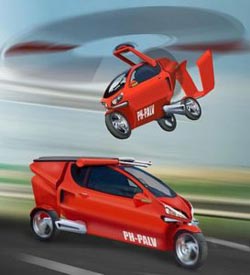“Flying Car company” takes off

Photo: pal-v.com
A number of investors have been found to back the start-up and currently initiatives are taken towards more investors to speed up market launch.
John Bakker has invested 6 years of his time in developing a vehicle concept that can fly as well as drive: PAL-V (Personal Air and Land Vehicle). A dream Henry Ford already had when he built the first car. This will be a revolution in door to door mobility in the near future. In countries with underdeveloped infrastructure it means safe and faster transportation but also in developed countries it will safe people lots of time.
The market response is huge. Already 2 mln hits have been recorded on the website. Daily mails are received from people that want to buy one. People have professional applications like surveillance, mobility for aid organisations, aid in post war situations, but also for private use bringing faster transportation or just big fun.
The PAL-V is a solution to increasing congestion in our cities, highways and skyways.
On the ground, the slim line, aerodynamic 3-wheel vehicle is as comfortable as a luxury car. But has the agility of a motorbike, thanks to its patented cutting-edge ‘tilting’ system. The single rotor and propeller are folded away until the PAL-V is ready to fly.
Airborne, the PAL-V flies under the 4,000 feet (1,500 m) floor of commercial air space. With land and air space reaching capacity, this is some of the last free space.
The PAL-V is highly fuel-efficient and powered by an environmentally certified car engine. It can run on petrol like a conventional car but can also run on biodiesel or bio-ethanol. It can reach speeds of up to 200 km/h both on land and in the air.
Like a helicopter, it has a Very Short Take Off and Vertical Landing (VSTOVL) capability making it possible to land practically anywhere. It can be driven to the nearest airfield or helipad and, because it flies below 4,000 feet, can take off without filing a flight plan. The autogyro technology means that it can be steered and landed safely even if the engine fails as it descends vertically rather than nose-diving. Lift is generated by the forward speed produced by the foldable push propeller on the back.
At less than 70 decibels it is more quiet than helicopters due to the slower rotating of the main rotor. A licence to fly the PAL-V is more accessible than one for a helicopter or plane because of the regulations controlling autogyro craft. In the United States and soon in Europe the infrastructure is in place for ‘digital freeways’ that provide a safe corridor using GPS technology to aid regulation and avoid collisions for low flying vehicles.
Soon private flying will no longer be the exclusive domain of executives and celebrities. If infrastructure does not exist or congestion or obstacles block the destination – fly. If the weather is too bad to fly – drive. Driving and flying combined in one vehicle that could cost little more than an executive saloon car.
John Bakker cooperated 6 years with well-known partners to develop the PAL-V concept. It is a combination of proven technologies. It fits within the new certification constraints and regulations that are in place since 2005 in the US and Europe.
Next to John Bakker the management team now consists of Robert Dingemanse who has championed several successful product launches and business start-ups at Philips Electronics and Jim Emanuels of Tacstone, specialised in starting up new businesses. This team has the right skills and experience to turn the concept into a business success.
For more information please contact:
www.PAL-V.com or Robert Dingemanse: +31-6-48313667, Dingemanse@PAL-V.com
Media Contact
More Information:
http://www.PAL-V.comAll latest news from the category: Automotive Engineering
Automotive Engineering highlights issues related to automobile manufacturing – including vehicle parts and accessories – and the environmental impact and safety of automotive products, production facilities and manufacturing processes.
innovations-report offers stimulating reports and articles on a variety of topics ranging from automobile fuel cells, hybrid technologies, energy saving vehicles and carbon particle filters to engine and brake technologies, driving safety and assistance systems.
Newest articles

Parallel Paths: Understanding Malaria Resistance in Chimpanzees and Humans
The closest relatives of humans adapt genetically to habitats and infections Survival of the Fittest: Genetic Adaptations Uncovered in Chimpanzees Görlitz, 10.01.2025. Chimpanzees have genetic adaptations that help them survive…

You are What You Eat—Stanford Study Links Fiber to Anti-Cancer Gene Modulation
The Fiber Gap: A Growing Concern in American Diets Fiber is well known to be an important part of a healthy diet, yet less than 10% of Americans eat the minimum recommended…

Trust Your Gut—RNA-Protein Discovery for Better Immunity
HIRI researchers uncover control mechanisms of polysaccharide utilization in Bacteroides thetaiotaomicron. Researchers at the Helmholtz Institute for RNA-based Infection Research (HIRI) and the Julius-Maximilians-Universität (JMU) in Würzburg have identified a…



